Newport News, VA Pollen and Allergy Report for Summer 2023
Pollen Allergy Trends in Newport News, VA
When is pollen lowest in Newport News, VA?

February
Lowest month total PPM
Avg. PPM
When is pollen highest in Newport News, VA?

April
Highest month total PPM
Avg. PPM
How does pollen in Newport News, VA compare to Virginia?
Newport News has a higher average PPM than the state of Virginia.
Newport News yearly avg PPM:
Virginia yearly avg PPM:
How does pollen in Newport News, VA compare to the USA?
Newport News has a higher average PPM than the USA.
Newport News yearly avg PPM:
USA yearly avg PPM:
Is pollen worse this year in Newport News, VA?
Spring 2023 was worse than spring 2022.
Spring 2023 PPM:
Spring 2022 PPM:
Average PPM in Newport News, VA
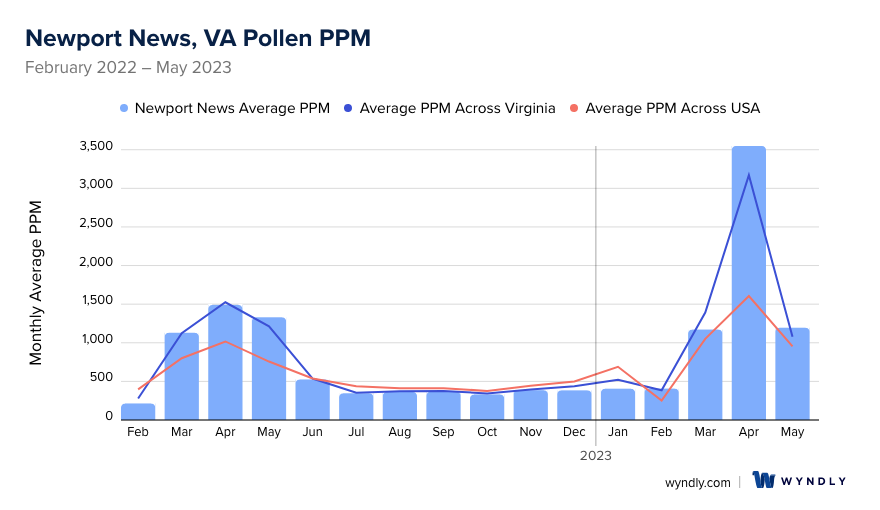
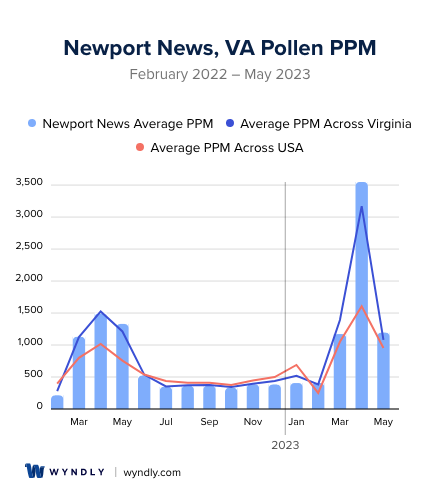
Newport News, VA Pollen and Allergy Breakdown by Month
Grass
When is grass pollen highest in Newport News, VA?
April has the highest grass pollen in Newport News, VA with an average PPM of
When is grass pollen lowest in Newport News, VA?
December has the lowest grass pollen in Newport News, VA with an average PPM of
Tree
When is tree pollen highest in Newport News, VA?
April has the highest tree pollen in Newport News, VA with an average PPM of
When is tree pollen lowest in Newport News, VA?
October has the lowest tree pollen in Newport News, VA with an average PPM of
Weed
When is weed pollen highest in Newport News, VA?
April has the highest weed pollen in Newport News, VA with an average PPM of
When is weed pollen lowest in Newport News, VA?
February has the lowest weed pollen in Newport News, VA with an average PPM of
Newport News, VA Pollen Monthly Breakdown by Pollen Type
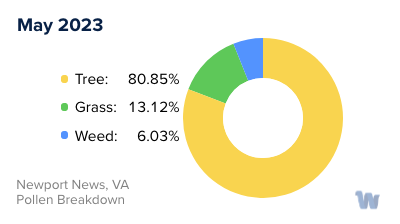
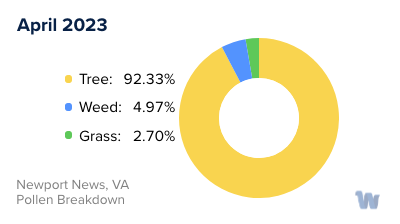
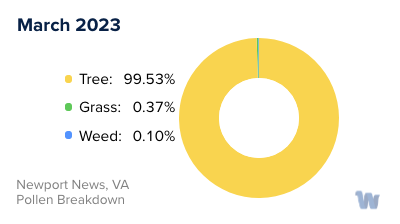
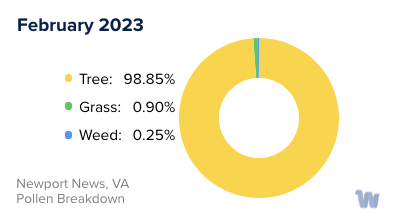
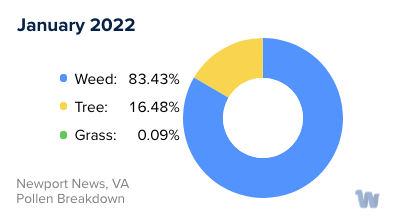
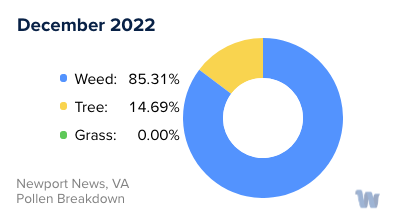
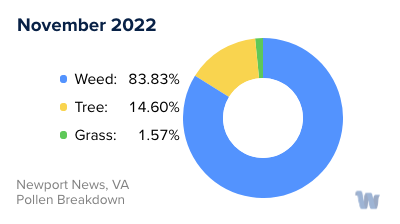
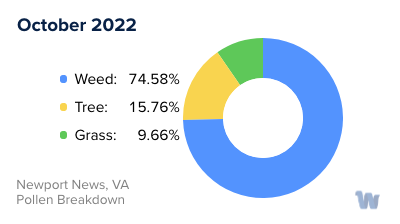
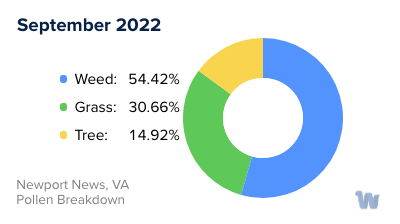
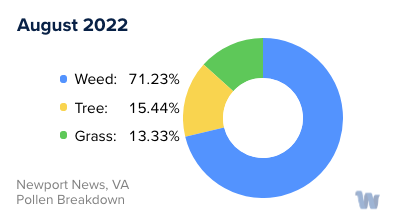
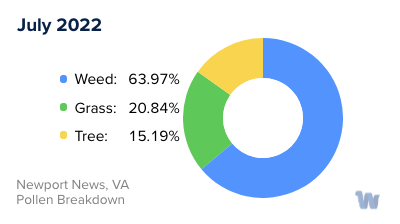
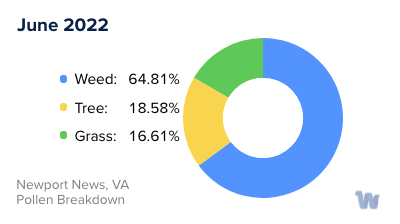
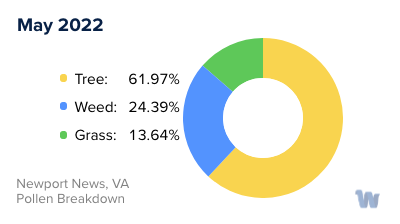
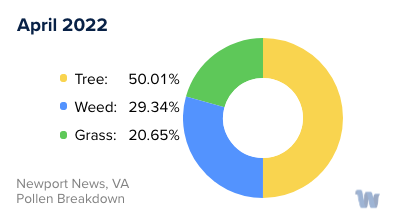
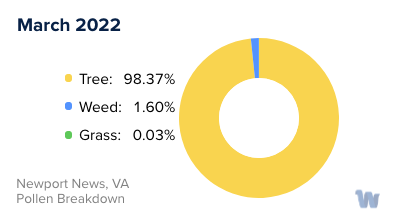
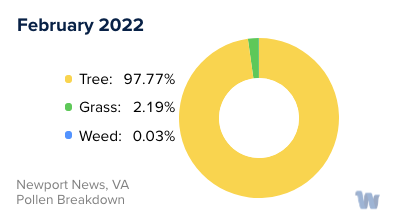
Pollen and Hay Fever in Newport News, VA
Located in the heart of Virginia, Newport News is a city that, despite its many charms, can pose some challenges for individuals with pollen allergies, also known as hay fever. These allergies are mainly caused by the pollen produced by grasses, trees, and weeds, which are abundantly present in the region.
Pollen allergies in Newport News can flare up during different parts of the year, depending on the type of pollen in question. Spring is the season when tree pollen takes center stage, with oak, river birch, and maple trees among the common culprits. The mild climate and abundant plant life in Virginia make it an ideal environment for these trees to thrive, resulting in a substantial amount of pollen in the air.
As we move into the summer, grass pollen becomes the primary concern. Species such as Bermuda grass, redtop grass, Johnson grass, Kentucky bluegrass, and orchard grass are common throughout Virginia and their pollen can often lead to uncomfortable allergy symptoms during the warmest months of the year.
With the arrival of late summer and fall, weeds step into the spotlight, further extending the pollen season. Ragweed, thistle, and goldenrod are all prevalent in the area, and their pollination can cause hay fever symptoms to persist right up until the end of fall.
The allergy season in Newport News generally starts in February, due to the region's fairly cold winters. However, the peak of the pollen season occurs in the warmer months, with April, May, and June often seeing the highest pollen counts. During these months, those with hay fever may find their symptoms are most severe and may need to take additional precautions, such as limiting their time outdoors or planning outdoor activities for the evening when pollen counts tend to be lower.
It is important to remember that although the outdoor allergen concern reduces with the onset of cold winters around November, indoor allergens can still pose challenges for many. Despite this, for pollen allergy sufferers in Newport News, the end of November usually signals a welcome break from hay fever until the cycle begins anew in the spring.

